 Credit: AMD
Credit: AMD
AMD’s highly anticipated Ryzen 4000 mobile CPUs may be built on the same 7nm process as the company’s wildly successfully Ryzen 3000 chips, but this time around the company is pinning the chip’s success on a carefully balanced design.
AMD officials said they’ve actually been working on the design for Ryzen 4000 mobile (code-named ‘Renoir’) since 2017, which, they note, predates the introduction of the company’s first Ryzen desktop chips.
The goal for the mobile chip couldn’t be more different. “The challenge in doing a notebook processor is balance: How do we balance the attributes that make it a good notebook processor?” said Dan Bouvier, AMD’s client products chief architect.
A laptop chip can’t go all-out like a desktop chip can. It has to consider the notebook chassis, the Z-height (thickness), the power envelope, and the battery life. “These are all opposing things that work against bringing higher performance,” Bouvier explained, “but you still want to balance that and bring the best performance.”
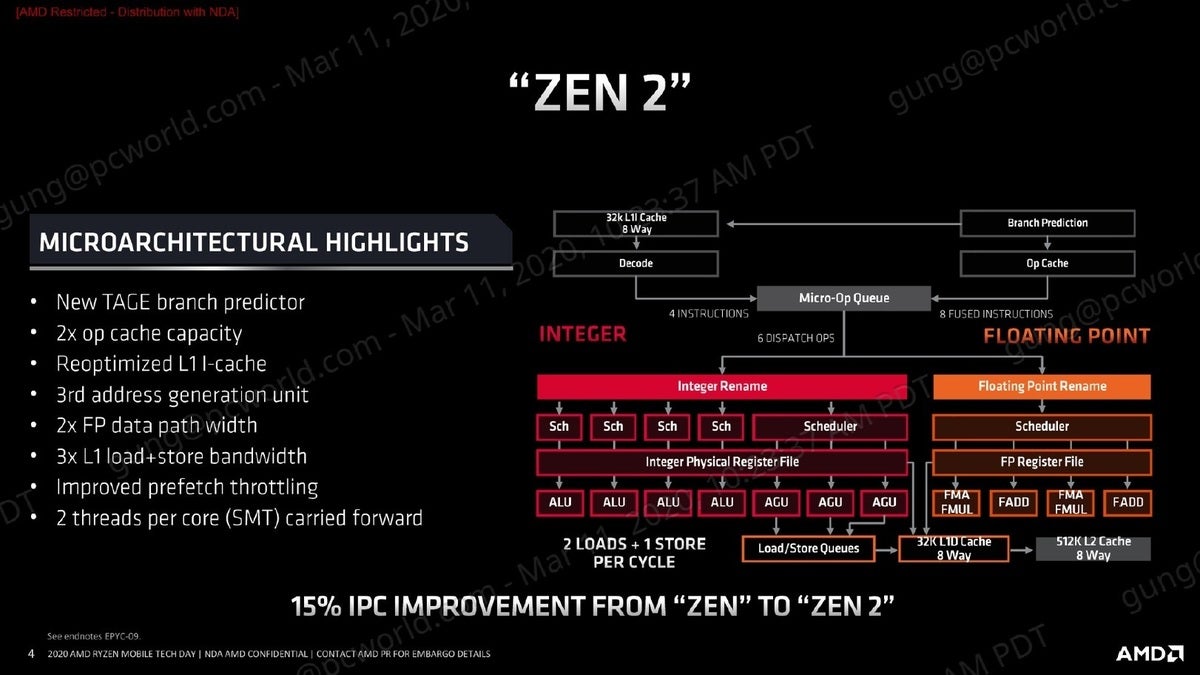 AMD
AMD
Most of the architectural changes with Zen 2 are well known, but its 15-percent increase in Instructions Per Clock (IPC) have made the Zen 2 the hit it is.
Bouvier added that AMD took a risk by stretching Renoir’s design beyond that of its quad-core predecessor. “When we started Renoir, we said, ‘let’s do quad-core, we’ll just make it faster.’” But Bouvier said AMD realized even more was possible so it aimed for a 6-core CPU. And once those models came back, AMD aimed even higher. “We started looking at the models and said, this is looking pretty good—let’s go further. So we did go eight cores, and we really went out on a limb.”
And remember, Bouvier pointed out: In 2017, competitor Intel was still selling a dual-core CPU.
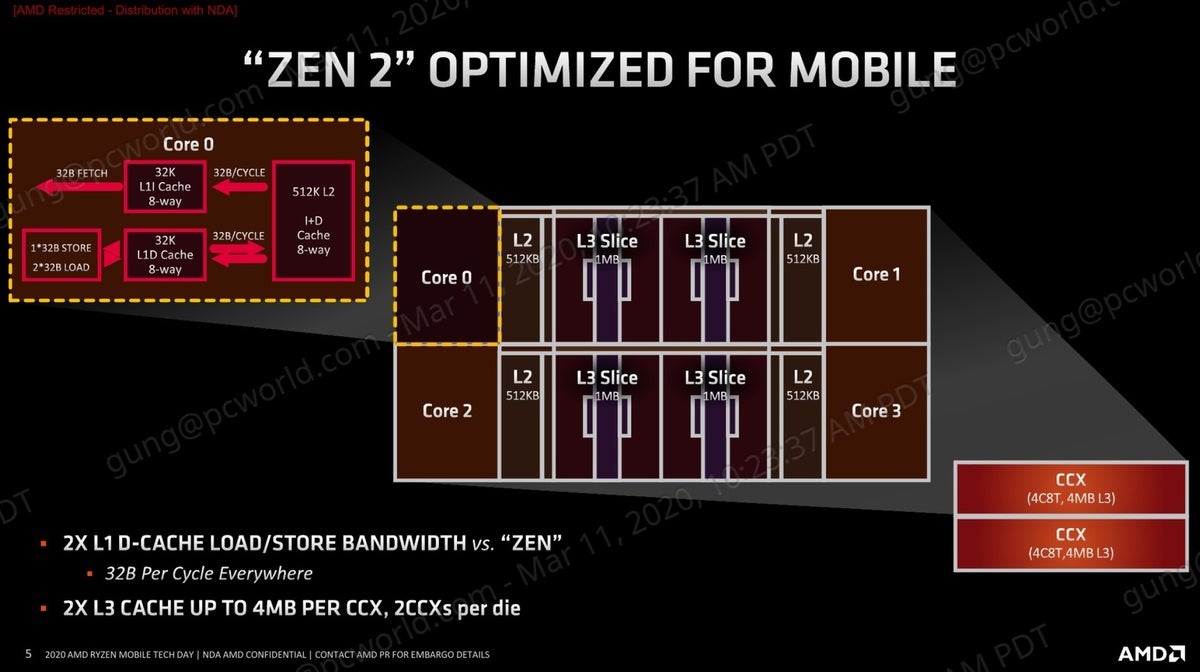 AMD
AMD
Two 4-core CCXs are used to build the basic Ryzen 4000 CPUs today.
The Ryzen 4000 CPU’s basic building block is essentially the same 7nm Zen 2 core AMD has used with its Ryzen 3000 series and third-generation Threadripper CPUs, but optimized for mobile. The basic building block of a mobile Ryzen is built on quad-core core complexes, or “CCX.” Each CCX features four cores with SMT and 512MB of L2 cache, plus a 1MB Level 3 cache that’s shared among all four cores. Two of the CCXs make up an 8-core chip.
You might expect AMD to use a single cluster for power efficiency needs. Bouvier described it as a “tradeoff,” but noted that the multi-CCX still enables very high bandwidth, very high frequency, and better power performance.
 AMD
AMD
Ryzen 4000 chips include highly optimized 7nm Radeon Vega graphics
7nm Vega: Not your Ryzen 3000’s Vega
When Ryzen 4000 was unveiled at CES, some were disappointed that its graphics are based on AMD’s older Radeon Vega cores, rather than the company’s newest Navi cores.
Bouvier said in 2017, when the chip was first sketched out, AMD didn’t think a mobile-optimized version of its Navi cores could be done in time. Luckily, Bouvier said, AMD also realized that the Vega architecture “still had a lot of gas in the tank.”
Many of the design decisions appear counterintuitive, Bouvier admitted. For example, while the 12nm Ryzen 7 3700U features 10 Vega Compute Units, the 7nm Ryzen 7 4800U features 8 Vega Compute units. “The reason is we studied this against our performance,” Bouvier explained. “As we shrink that engine down, everything got closer together, the wires got closer together, and we’re now able to run at a much higher frequency. So we traded area, which is good in a mobile device, for frequency, and 7nm gave us that.”
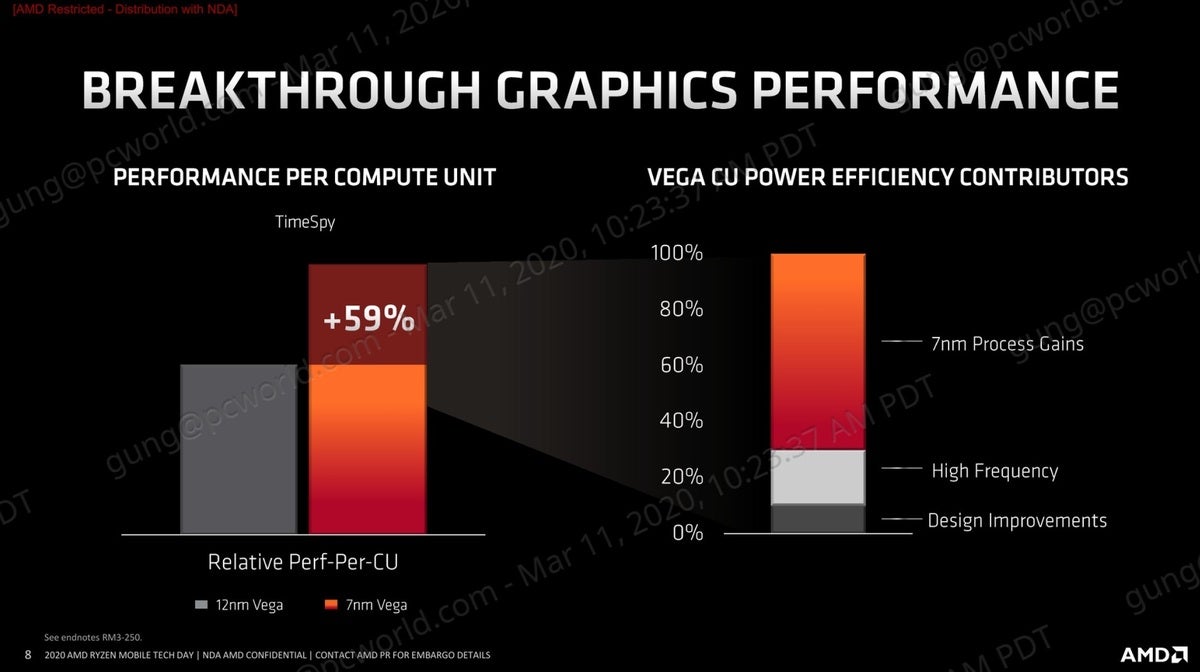 AMD
AMD
AMD said it will pick up 59 percent more performance per graphics compute unit over the previous gen Ryzen in large part thanks to the smaller 7nm process, higher clock speeds and architecture changes.
AMD says the newer 7nm-based Vega cores will offer a blistering 59 percent more performance per CU than the 12nm Vega cores in the Ryzen 7 3700U chip.
AMD silicon doesn’t get all the credit for the performance uplift though. Bouvier said that the platform greatly benefits from faster memory support. “In designing APUs, this is our biggest nemesis,” Bouvier said. “DDR(4) memory is not going faster and faster.” By moving to LPDDR4X support at up to 4,266MHz, Ryzen 4000 laptops gain a 77-percent uptick in memory bandwidth, according to Bouvier.
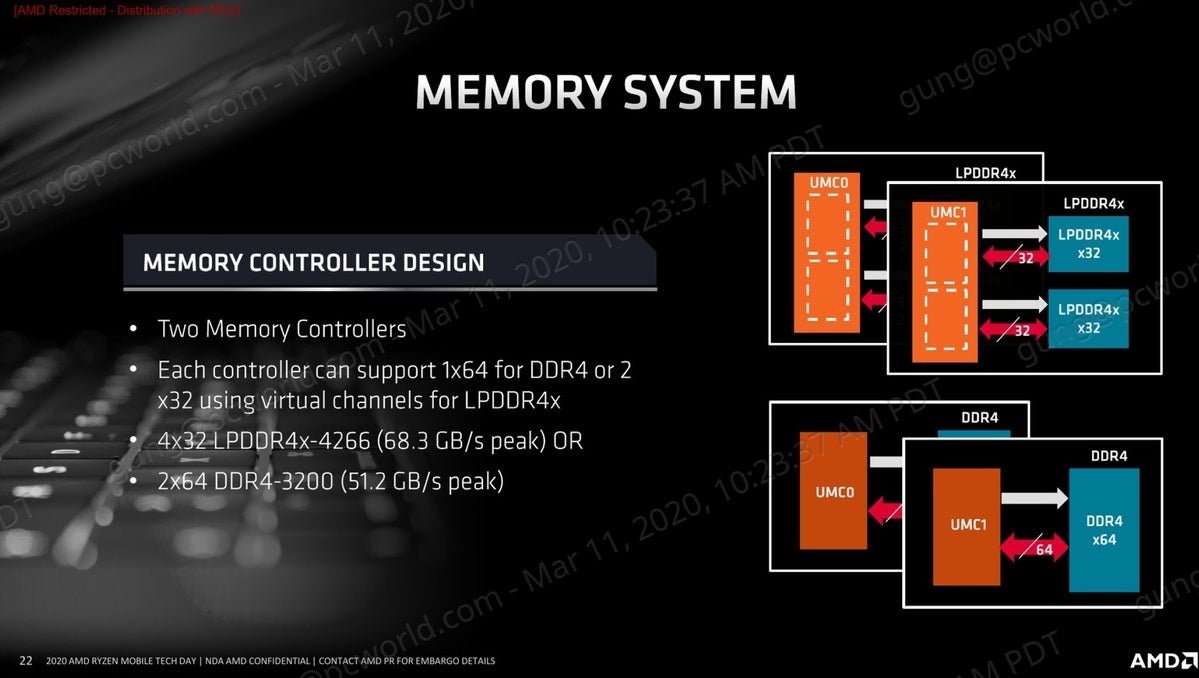 AMD
AMD
AMD’s Ryzen 4000 chips will pick up 77 percent more memory bandwidth over previous versions by using LPDDR4X/4266.
Battery life matters
While AMD’s first-gen 12nm Ryzen offered reasonable raw performance, they typically got blown out by Intel’s CPUs in battery life. That won’t likely be the same with Ryzen 4000, which will be far faster and far more efficient, AMD said.
“What we wanted to do is take a dragster engine, put it in an SUV, but still get Prius efficiency,” said AMD senior fellow Scott Swanstrom, referring in the latter case to Toyota’s pioneering fuel-efficient hybrid. “That was really the challenge for this product.” To do that, AMD made some significant changes to how the CPU manages its power states and its boost states.
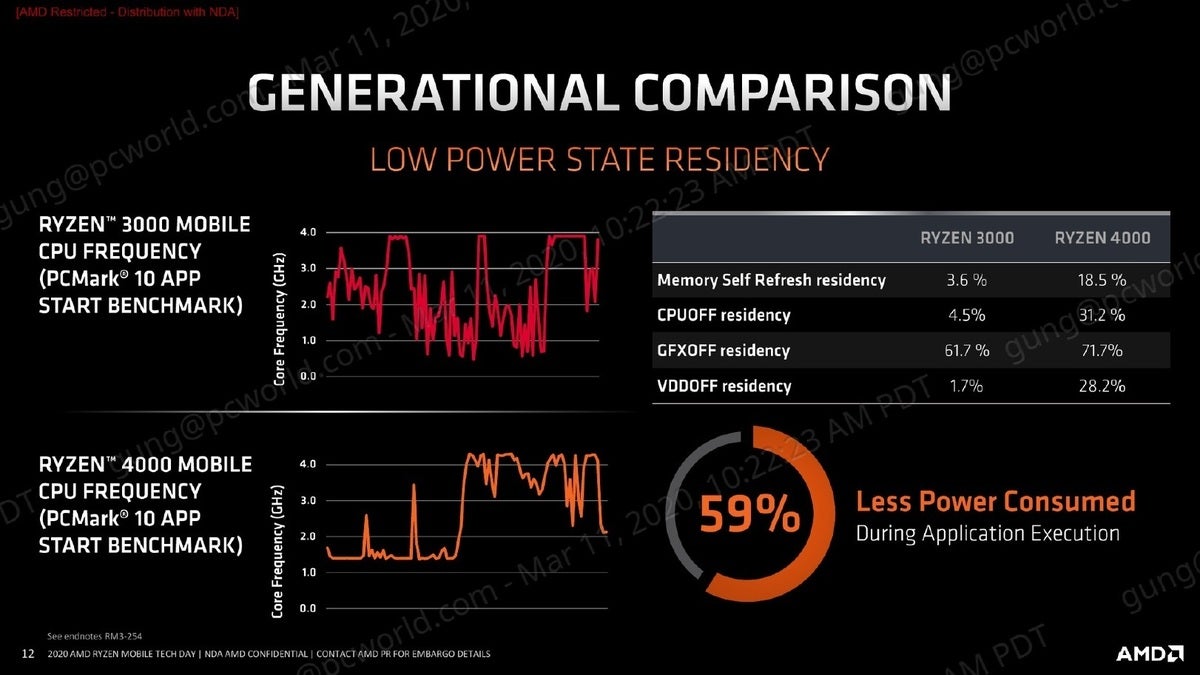 AMD
AMD
AMD said the new Ryzen 4000 CPUs consume 59 percent less power compared to Ryzen 3000 CPUs during an application, because the chip spends more time in a low-power state.
AMD said one issue it solved in the move from the 12nm Ryzen 3000 mobile chips was ramping in and out from low power states. While it may sound good to ramp into a low power state as much as possible, the previous generation of chip was “overly aggressive” with it, Swanstrom said. Ryzen 3000 would ping-pong back and forth, which actually wasted power efficiency. With the Ryzen 4000, as you can see below, AMD largely avoids the see-saw and uses less power.
Swanstrom said Ryzen 4000 does this through looking at driver feedback, BIOS feedback, and OS feedback, as well as sensors placed in the laptop and in the CPU itself. For example, the graphics driver might look at whether it’s running a 3D-intensive load and then flag the system’s System Management Controller to let it know more power is needed.
While most of the time the System Management Controller will try to monitor the hardware and software to predict what performance to provide, Swanstrom said Ryzen 4000 will be closely tied with Windows 10’s Power Slider UI.
Today, the Power Slider UI doesn’t seem to do much on most laptops, but on many Ryzen 4000-based systems, it should actually give you more performance or actually maximize battery life. Many OEMs choose to provide their own power controls as well, and those will still exist with Ryzen 4000 laptops.
 AMD
AMD
AMD’s System Management Controll is based mostly in firmware and knows if the laptop has a discrete graphics card and can budget power to different blocks of the laptop.
Maximum Boost
Modern laptops have long exploited boost clocks modes to extract the most amount of performance from a chip. AMD’s Ryzen 4000 will feature two modes to boost the clocks as high and as long as possible.
Both methods rely on telemetry data from the CPU itself as well as remote temperature diodes placed in the laptop chassis.
The first is Skin Temperature Aware Power Management, or STAPM. This is how AMD mainly tunes for high clocks on bursty or short loads. For example, if you were to launch a webpage and start to browse, STAPM would push the clock speeds and power usage as hard as possible and even exceed the CPU’s rated long-term thermal or power limits for a few micro-seconds. In some ways, it’s somewhat analogous to Intel’s Power Limit settings, which typically dictate power usage and clock speeds for very short duration.
Once the CPU’s power management has reached its limit and realizes that no, this isn’t a burst load, AMD’s System Temperature Tracking V2 technology kicks it.
STT V2 looks at the diodes that measure the temperature on the bottom of the laptop, or the keyboard, or near the GPU, and decides just how hard the processor can keep pushing. Laptop makers decide where the diodes go and just how hot the laptop skin can get, but AMD said STT V2 can typically extend a burst clock duration by 4x versus what using STAPM or STAPM-like techniques alone.
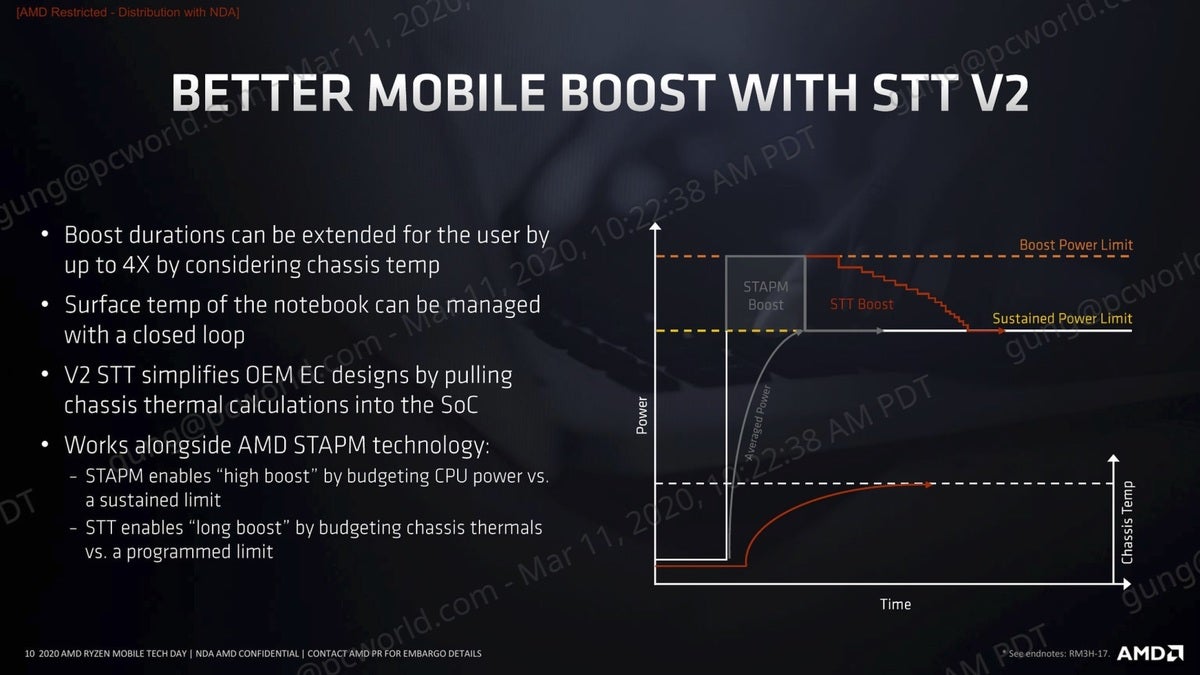 AMD
AMD
AMD’s STT V2 and STAPM are the guard rails on just how hard and how long the new Ryzen 4000 can boost to its maximum clock speeds. STAPM mainly guides short burst boosts while STT V2 controls long duration boost loads by considering laptop skin temp.
Conclusion: Now we wait
In the end, this sounds very impressive, but it’s just theory until we start to see Ryzen 4000 CPUs in shipping laptops. Still, we shouldn’t understate just how significant this is for AMD: For the first time in its history, it may very well be the lead in laptops.

















